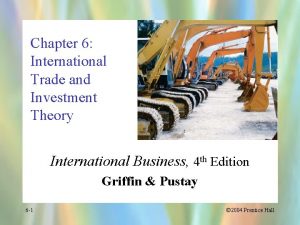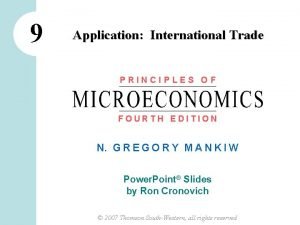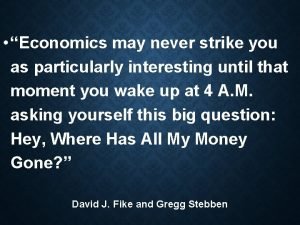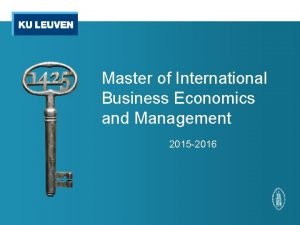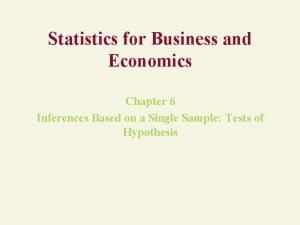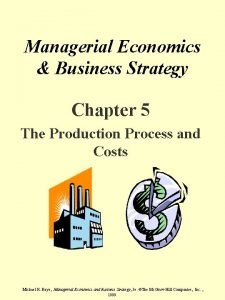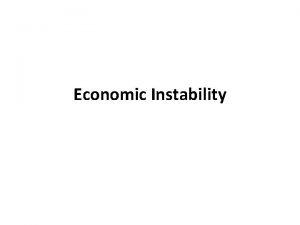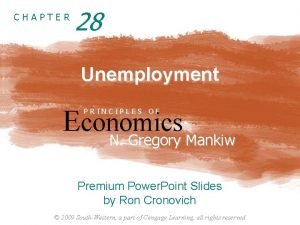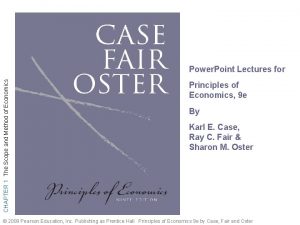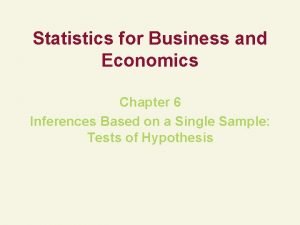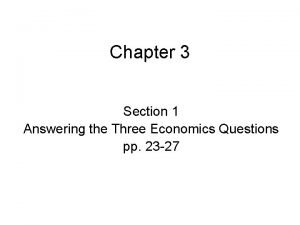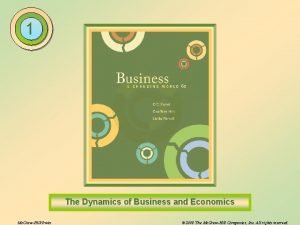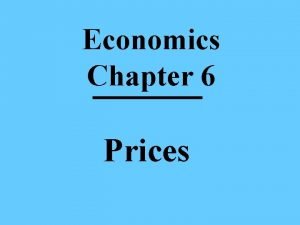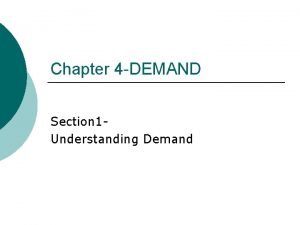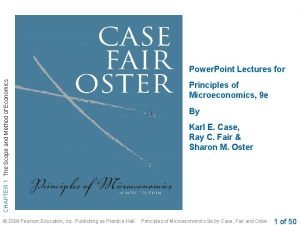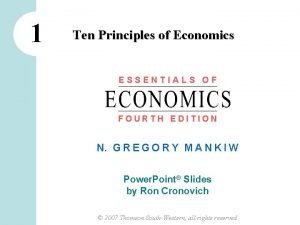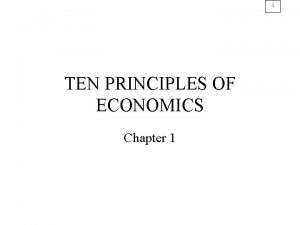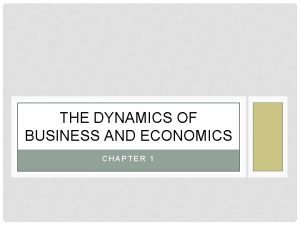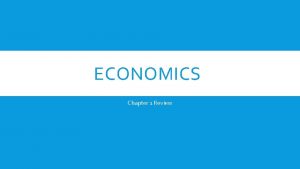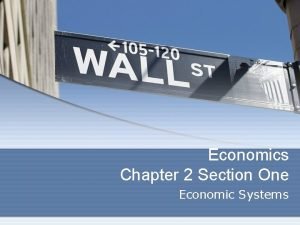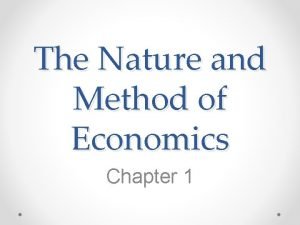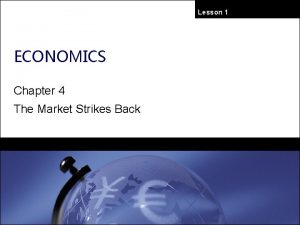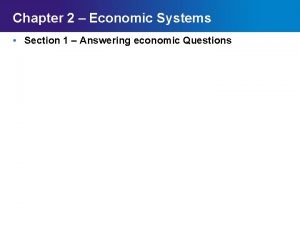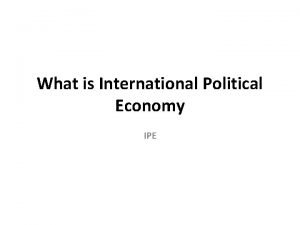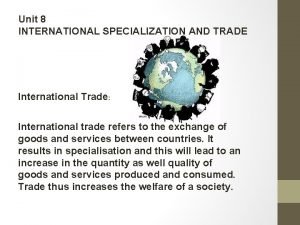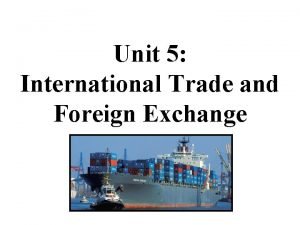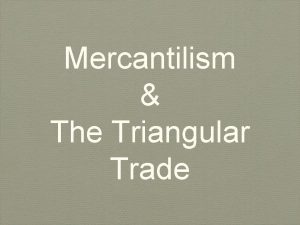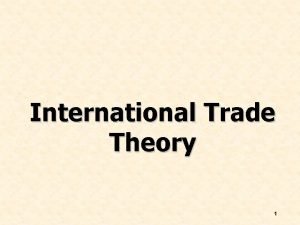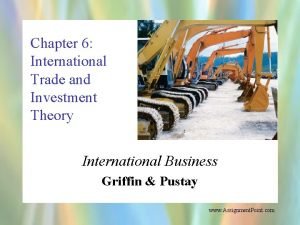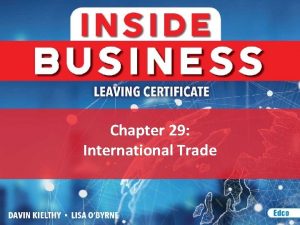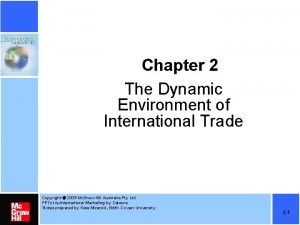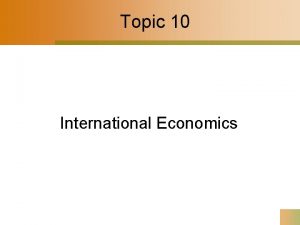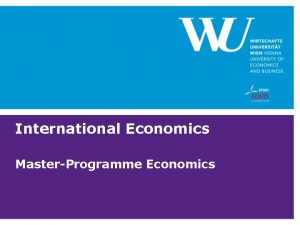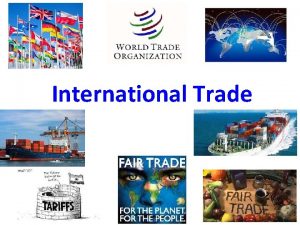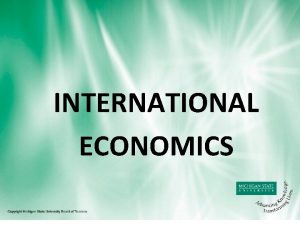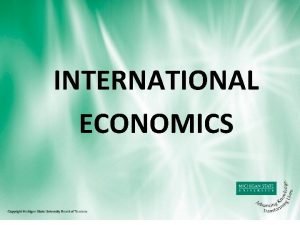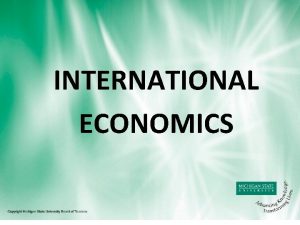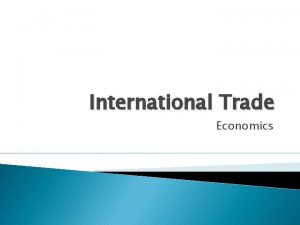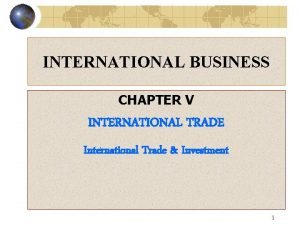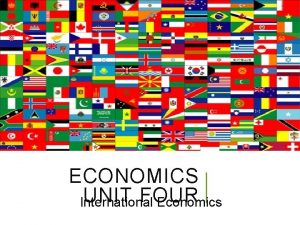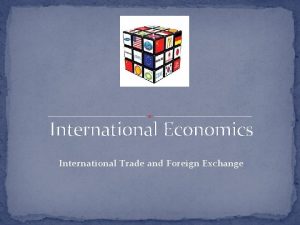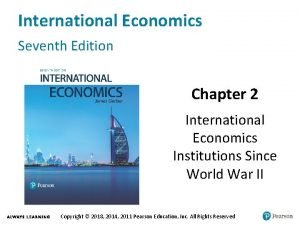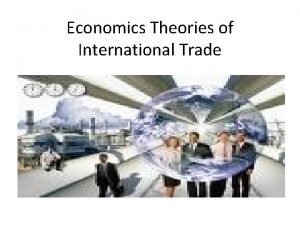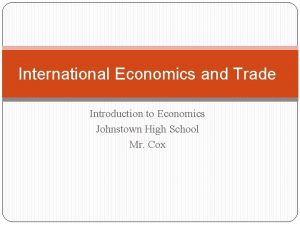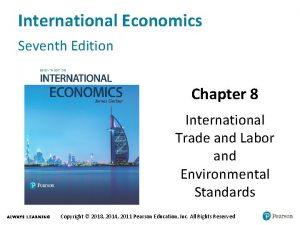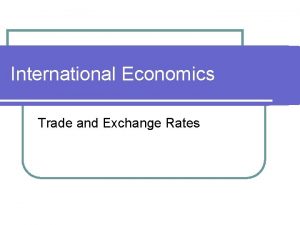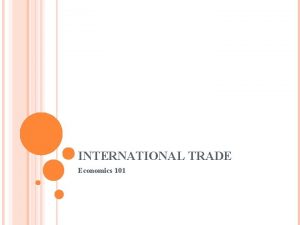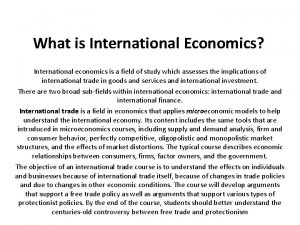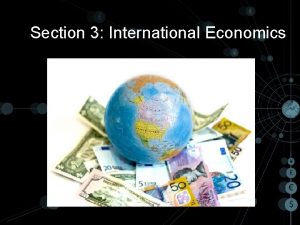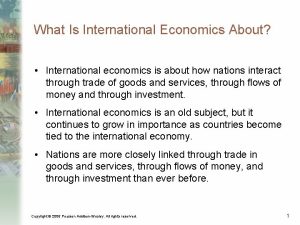Economics Chapter 8 International trade International trade Trade























































- Slides: 55

Economics Chapter 8 International trade

International trade Trade: l Exchange of goods and services International trade: l Exchange of goods and services between countries or regions. l Example 1. USA and China l USA sells computer to China l China sells garment to USA 2. HK and other regions l exports electronics goods l Imports rice and cars

International trade l

International trade l

International trade l

Mutual benefits Why trading? If exports / imports HK USA Trade? Loss Gain � l Mutual benefits l Free trade benefits both buyers and sellers. l Exporting country will gain from Px > Production cost, PX > PL l Importing country will gain from PM < Production cost, PM < PL

Absolute advantage Definition l l l Adam Smith If a country can produce more Good X than other countries by using the same amount of resources, then this country has an absolute advantage in producing Good X. Given the same input of resources: Production of Good X China USA 1, 000 units 300 units l China has an absolute advantage in producing Good X l Conversely, USA has an absolute disadvantage.

Absolute advantage l Comparison of same goods among countries. l Determined by productivity. l Technologically advanced higher productivity in all good absolute advantage l Conversely, low level technology low productivity absolute disadvantage

Absolute advantage Each unit of resources can produce: Good X (units) Good Y (units) Country A 85 or 25 Country B 120 or 40 Yes a. Country B must have more resources. b. Country B is more technologically advanced. � � c. Country B must have a higher total output than Country A. d. Country B has an absolute advantage in the production of both goods. e. Country B has an absolute advantage in producing Good X since each unit of resources can produce more X than Y. No � � ∵ Compare the same goods among countries �

Case study: Absolute advantage Suppose Japan and USA both have 2, 000 units of resources. They use half of their resource (1, 000 units) to produce food and clothes on their own. Total resources (units) Total production of food (units) USA 2, 000 5, 000 and 6, 000 Japan 2, 000 4, 000 and 8, 000 Total output - 9, 000 and 14, 000 Total production of clothes (units)

Case study: Absolute advantage Each unit of resources can produce: Food (units) Clothes (units) USA 5 or 6 Japan 4 or 8 For each unit of resources l USA produce more food than Japan USA has absolute advantage on food Japan has absolute disadvantage on food l Japan produce more clothes than USA Japan has absolute advantage on clothes USA has absolute disadvantage on clothes

Case study: Absolute advantage Suppose Japan and USA specialize on producing goods with absolute advantages, i. e. USA uses all the resources to produce food. Japan uses all the resources to produce clothes. Total resources (units) Total production of food (units) USA 2, 000 10, 000 and 0 Japan 2, 000 0 and 16, 000 Total output - 10, 000 and 16, 000 Total output of food and clothes � Total production of clothes (units)

Case study: Absolute advantage Suppose USA exchanges 4, 500 units of food for 7, 000 units of clothes with Japan. After international trade: Total resources (units) Total production of food (units) Total production of clothes (units) USA 2, 000 5, 500 and 7, 000 Japan 2, 000 4, 500 and 9, 000 Total output - 10, 000 and 16, 000 Compare with the output before trade: Total resources (units) Total production of food (units) Total production of clothes (units) USA 2, 000 5, 000 and 6, 000 Japan 2, 000 4, 000 and 8, 000 Total output - 9, 000 and 14, 000

Case study: Absolute advantage Assume that l Free trade l No transaction cost Through international trade l USA gains l 500 units of food l 1, 000 units of clothes l Total output l l Japan gains 500 units of food 1, 000 units of clothes � 1, 000 units of food � 2, 000 units of clothes Conclusion l Specialize in production of goods with absolute advantage l Through international trade l Mutual benefits

Comparative advantage Definition l David Ricardo l A country can produce Good X at a lower opportunity cost than other countries. Limitation of the principle of absolute advantage l A technologically advanced country Absolute advantage in all goods Why import? ? ? l E. g. l Japan has high level of technology l Absolute advantage in all goods, but still imports from other countries

Comparative advantage Each unit of resources can produce: Good X (units) Good Y (units) Country A 50 or 25 Country B 10 or 2 Country A has absolute advantage in both Good X and Y.

Comparative advantage l

Comparative advantage Convert the table to show the opportunity cost: Good X (units) Good Y (units) Country A 50 or 25 Country B 10 or 2 Good X Good Y Country A or Country B or Table 8. 2: Unit costs of producing Good X and Y in Country A and B.

Comparative advantage Good X Good Y Country A 0. 5 Y or 2 X Country B 0. 2 Y or 5 X Table 8. 2: Unit costs of producing Good X and Y in Country A and B. l Country A has a lower opportunity cost in producing Good Y. Country A has comparative advantage in Good Y. l Country B has lower opportunity cost in producing Good X. Country B has comparative advantage in Good X. l No country can have a comparative advantage in all goods. l Low opportunity cost in Good X High opportunity cost in Good Y

Comparative advantage Textbook p. 36 Each unit of resources can produce: Good X (units) Good Y (units) Country A 6, 000 or 7, 200 Country B 4, 000 or 6, 000 Good X Good Y Country A or Country B or Table 8. 2: Unit costs of producing Good X and Y in Country A and B.

Comparative advantage Each unit of resources can produce: Good X (units) Good Y (units) Country A 6, 000 or 7, 200 Country B 4, 000 or 6, 000 Yes a. Country A has more resources. No � b. Country A has an absolute advantage in producing Good X. � c. Country A has a comparative advantage in producing Good X. � d. Country A has a comparative disadvantage in producing Good X. � Country A has a comparative advantage in producing Good X e. since the opportunity cost of producing Good X is lower than that of Good Y. � ∵ Compare the same goods among countries

Absolute advantage & Comparative advantage l l Absolute advantage: l A country with high productivity (usu. �technology) l Can be all types of goods Comparative advantage l A country with lower costs in producing a certain kind of goods l Comparatively a certain kinds of goods only

Principle of comparative advantage l 1. If a country specializes in and exports goods in which it has a comparative advantage, and 2. imports goods in which it has comparative disadvantage, the world’s total output will increase and both countries will benefit.

Principle of comparative advantage l Assumptions l Only 2 countries, Country A and Country B l Only 2 types of goods, Goods X and Goods Y l Amount of goods produced by each unit of resources is fixed l Barter system (exchange of goods) l No transaction cost

Comparative advantage Good X Good Y Country A 0. 5 Y or 2 X Country B 0. 2 Y or 5 X Table 8. 2: Unit costs of producing Good X and Y in Country A and B. Country A vs. Country B Produce 1 X 0. 5 Y 0. 2 Y Produce 1 Y 2 X 5 X Table 8. 3: Unit costs of Country A and B. Lower cost A should produce Good Y Lower cost B should produce Good X

Principle of comparative advantage l Therefore, after specialization: Country A Country B Specialize production in Good Y Good X Exports Good Y Good X Imports Good X Good Y

Comparative advantage Country A vs. Country B Produce 1 X 0. 5 Y 0. 2 Y Produce 1 Y 2 X 5 X Table 8. 3: Unit costs of Country A and B. After specialization (Good X) Effect on Good X Effect on Good Y Country A produces 1 less unit of X - 1 X +0. 5 Y Country B produces 1 more unit of X +1 X -0. 2 Y Total output Unchanged +0. 3 Y

Comparative advantage Country A vs. Country B Produce 1 X 0. 5 Y 0. 2 Y Produce 1 Y 2 X 5 X Table 8. 3: Unit costs of Country A and B. After specialization (Good Y) Effect on Good X Effect on Good Y Country A produces 1 more unit of Y - 2 X +1 Y Country B produces 1 less unit of Y +5 X -1 Y Total output +3 X Unchanged

Potential gain from trade Potential gain (highest possible gain) l Gain before deducting the cost (transaction cost) of trade, such as transportation costs l If transaction cost is involved, Actual gain < Potential gain

Potential gain from trade After specialization (Good X) Effect on Good X Effect on Good Y Country A produces 1 less unit of X - 1 X +0. 5 Y Country B produces 1 more unit of X +1 X -0. 2 Y Total output Unchanged +0. 3 Y l Cost saved by Country A = 0. 5 Y l Cost paid by Country B = 0. 2 Y l World Total cost saving = 0. 3 Y l Total increase in output = World total cost saving = 0. 3 Y

Potential gain from trade From the example: l Countries specialize in producing goods with lower opportunity cost l International trade is mutually beneficial to 2 countries l Potential gain form trade = Cost difference between 2 countries = 0. 3 Y l Next questions: l Which country gains more? l Is the gain evenly distributed among 2 countries?

Terms of trade determine the distribution of gains Before trade: Country A vs. Country B Produce 1 X 0. 5 Y 0. 2 Y Produce 1 Y 2 X 5 X Table 8. 3: Unit costs of Country A and B. Suppose the terms of trade: 1 X = 0. 4 Y Country A’s gain from importing 1 X Country B’s gain from exporting 1 X Domestic cost of 1 X 0. 5 Y Domestic cost of 1 X 0. 2 Y Import price 0. 4 Y Export price 0. 4 Y Cost saved 0. 1 Y Gain 0. 2 Y Trade. Total gain is shared by Country A (0. 1 Y) & B (0. 2 Y)

Terms of trade determine the distribution of gains Before trade: Country A vs. Country B Produce 1 X 0. 5 Y 0. 2 Y Produce 1 Y 2 X 5 X Table 8. 3: Unit costs of Country A and B. Suppose the terms of trade: 1 X = 0. 3 Y Country A’s gain from importing 1 X Country B’s gain from exporting 1 X Domestic cost of 1 X 0. 5 Y Domestic cost of 1 X 0. 2 Y Import price 0. 3 Y Export price 0. 3 Y Cost saved 0. 2 Y Gain 0. 1 Y Trade. Total gain is shared by Country A (0. 2 Y) & B (0. 1 Y)

Terms of trade determine the distribution of gains Before trade: Country A Country B vs. Produce 1 X 0. 5 Y 0. 2 Y Produce 1 Y 2 X 5 X Table 8. 3: Unit costs of Country A and B. Suppose the terms of trade: 1 X = 0. 1 Y Country A’s gain from importing 1 X Country B’s gain from exporting 1 X Domestic cost of 1 X 0. 5 Y Domestic cost of 1 X 0. 2 Y Import price 0. 1 Y Export price 0. 1 Y Cost saved 0. 4 Y Loss 0. 1 Y No trade. Country B will lose if trading.

Case study (textbook p. 39) Given the domestic costs: l Country A: 1 Y = 2 X and Country B: 1 Y = 5 X l l Opportunity cost Country A Country B Produce 1 X 0. 5 Y 0. 2 Y Produce 1 Y 2 X 5 X Country A exports Good Y, because opportunity cost is lower. Conversely, Country B exports Good X. Term of trade Exports Y A’s gain B’gain 1 Y = 1 X No trade - - 1 Y = 2 X Country A 0 3 X 1 Y = 3 X Country A 1 X 2 X 1 Y = 4 X Country A 2 X 1 X 1 Y = 5 X Country A 3 X 0 1 Y = 6 X No trade - - Mutual benefits

Case study (textbook p. 39) Conclusion l Mutual benefits l Cost of importers > Terms of trade > Cost of exporters l If term of trade = Cost of importer l l l If term of trade = Cost of exporter l l l Importer’s gain = max. (i. e. potential gain) Exporter’s gain = 0 If term of trade > cost of importer or term of trade < cost of exporter l l Importer’s gain = 0 Exporter’s gain = max. (i. e. potential gain) No trade Determination of term of trade l Depends on the bargaining power of the countries l E. g. Bilateral trade negotiations bet. USA and China

Conditions for mutually beneficial trade l Each party has a comparative advantage l Different opportunity costs in producing different goods l Mutual beneficial terms of trade l Terms of trade lies between domestic costs of both parties l Cost of importer > Terms of trade > Cost of exporter l Reasonable cost of trade l Low transaction cost l l l Transportation Negotiation Trade protection policies

Advantages of international trade Social development l l Exchange of products l Native products l E. g. teapots, art-crafts Cultural interflow l Cultural exchange during communication and negotiation l E. g. Western businessmen learn Chinese culture

Advantages of international trade Economical aspect l Comparative advantage l Lower cost l Specialization l More experience and knowledge l Better use of technology l Economies of scales l Specialization allows increasing scale of production l Thus, lower average cost l Technological interflow l Trade enhance technological interflow l Higher productivity l Enhancement of competition l Higher quality of domestic products l Lower cost to produce domestic products with advanced technology

The effects of exchange rate on international trade Think about this: A Japanese car costs ¥ 1, 500, 000 Assume the exchange rate is HKD 1 = JPY 10 How much should a HK citizen pay for this car in terms of HKD? l HK$ 1 can be converted into JP¥ 10 l The car costs HK$1, 500, 000 / 10 = HK$150, 000 If HKD depreciates against JPY, what do you think about the price of the car in terms of HKD? l If the exchange rate is now HKD 1=JPY 9, l The car costs HK$1, 500, 000 / 9 = HK$166, 666. 67 The same car, but the price �. l HK people suffer.

The effects of exchange rate on international trade Think about this: Assume you have no special preference towards rice from different countries. If l HKD depreciates against AUD, and l HKD appreciates against THB (Thai Baht). Which one will you choose? Why?

Depreciation and exports Suppose garments are exported to Europe. Price of garment made in HK = HK$100 Exchange rate: HK$100 = € 11 Export price = € 11 P (€) HKD depreciation: Exchange rate: HK$100 = € 10 Local price = HK$100 Export price = € 10 Price � Qd� (Law of demand) HK garments 11 10 0 Q 1 Q 2 That is, quantity demanded of HK garment export increases. Export volume

Appreciation and exports Suppose garments are exported to Europe. Price of garment made in HK = HK$100 Exchange rate: HK$100 = € 11 Export price = € 11 P (€) HKD appreciation: Exchange rate: HK$100 = € 12 Local price = HK$100 Export price = $100 = € 12 Price � Qd� (Law of demand) HK garments 12 11 0 Q 2 Q 1 That is, quantity demanded of HK garment export decreases. Export volume

Depreciation and imports Suppose watches are imported from Europe. Price of European watch = € 110 P ($) Exchange rate: HK$100 = € 11 Import price = HK$1000 HKD depreciation: Exchange rate: HK$100 = € 10 European watches 1100 1000 Import price = $110 x (100/10) = HK$1100 Price � Qd� (Law of demand) 0 Q 2 Q 1 Import volume That is, quantity demanded of European watches import decreases.

Appreciation and imports Suppose watches are imported from Europe. Price of European watch = € 110 P ($) Exchange rate: HK$100 = € 11 Import price = HK$1000 HKD appreciation: Exchange rate: HK$100 = € 12 European watches 1000 916. 7 Import price = $110 x (100/12) = HK$916. 7 0 Price � Qd� (Law of demand) Q 1 Q 2 Import volume That is, quantity demanded of European watches import increases.

The effects of exchange rate on international trade Summary Exports Price Imports Qd Price Qd Depreciation � � Appreciation � � Case study in textbook p. 46: Change in revenue which is brought be depreciation or appreciation depends on the price elasticity of demand. Try yourself!!!

Trade in Hong Kong Merchandise trade (Goods) l Exports l l Garments Electronic products Toys Jewellery (accounted for more than 60% of total domestic exports in 2008)

Trade in Hong Kong Merchandise trade (Goods) l Retained imports l l l Raw materials (e. g. gold, silver) Semi-finished goods (e. g. LCD display, plastic button) Capital goods (e. g. truck, machine) Consumption goods (e. g. clothes, TV) Fuel Food (accounted for more than 99% of total retained imports in 2008)

Trade in Hong Kong Trade in services l Exports of services (Exports have higher value than imports) l l l Financial consultation Commerce Accounting Transportation Entertainment Imports of services (Imports have higher value than exports) l l Tourism Insurance

Trade in Hong Kong Major trading partners Value of goods High Low Total trade volume Import suppliers The Mainland Export markets USA Re-exports Sources Destinations The Mainland USA Japan The Mainland Japan USA Japan Taiwan Netherlands Taiwan Japan Taiwan Korea UK Korea Germany

Trade in Hong Kong Trade based on comparative advantage l Low opportunity cost: Exports l Goods (e. g. garments, electronic products) l Services l Low opportunity cost: Re-exports l High opportunity cost: Imports l Goods (e. g. capital goods) l Services

Importance of trade to Hong Kong’s economy l Acquiring consumption goods and raw materials l HK is lack of resources l Rely on imports l Hugh demand of daily necessities (e. g. food) and raw materials (e. g. coal) l Favourable to the development of high valueadded industries l l HK has comparative advantage in specializing in value-added industries E. g. finance and commercial industrials

Importance of trade to Hong Kong’s economy l Trade generates huge income l In 2010, GDP = $1, 748. 1 billion l Exports l l l Value of exports of goods l Imports l Value of imports of goods = $3, 061. 3 billion = $3, 395. 1 billion (175. 1% of GDP) (194. 2% of GDP) Value of exports of services l Value of imports of services = $835. 0 billion = $396. 6 billion (47. 8% of GDP) (22. 7% of GDP) International trade is very important to HK economy

Pros and Cons of free trade l Pros l Consumers l More choices l Cheaper and higher quality imported goods l Workers l Products can be sold worldwide More job opportunity l More profits Higher wages l Businessmen l Open new markets More profits l Owners of Trading firm l More business for the company l Service providers (e. g. banks, transportation firms) l More business More income

Pros and Cons of free trade l Cons l Workers l Keen international competition Close down of factories unemployment or less profits Lower wages l Local famers l Large quantity imported farm products Less sales Poor livelihood l Local consumers l High quality products are for exports Buy only low quality products locally
 School of business and economics maastricht
School of business and economics maastricht Mathematical vs non mathematical economics
Mathematical vs non mathematical economics Chapter 6 theories of international trade and investment
Chapter 6 theories of international trade and investment Chapter 9 application: international trade answers
Chapter 9 application: international trade answers Trade off and opportunity cost
Trade off and opportunity cost Trade-off economics example
Trade-off economics example Ibfe manchester
Ibfe manchester Ku leuven international business economics and management
Ku leuven international business economics and management Ku leuven international business economics and management
Ku leuven international business economics and management International development economics associates
International development economics associates Trade diversion and trade creation
Trade diversion and trade creation Umich
Umich Which is the most enduring free trade area in the world?
Which is the most enduring free trade area in the world? The trade in the trade-to-gdp ratio
The trade in the trade-to-gdp ratio Fair trade not free trade
Fair trade not free trade Trade diversion and trade creation
Trade diversion and trade creation Liner trade and tramp trade
Liner trade and tramp trade What is triangle trade
What is triangle trade Statistics for business and economics chapter 6 solutions
Statistics for business and economics chapter 6 solutions Ecomics
Ecomics Combination of inflation and unmoving economic growth
Combination of inflation and unmoving economic growth Chapter 28 unemployment
Chapter 28 unemployment The scope and method of economics chapter 1
The scope and method of economics chapter 1 When to use z test and t test
When to use z test and t test Economics chapter 3 section 1 answer key
Economics chapter 3 section 1 answer key Chapter 1 ten principles of economics
Chapter 1 ten principles of economics Chapter 1 the dynamics of business and economics
Chapter 1 the dynamics of business and economics Chapter 2 economics and environmental policy
Chapter 2 economics and environmental policy Chapter 6 section 1 economics
Chapter 6 section 1 economics Economics chapter 4 section 1 understanding demand answers
Economics chapter 4 section 1 understanding demand answers Basic concepts in managerial economics
Basic concepts in managerial economics The scope and method of economics chapter 1
The scope and method of economics chapter 1 One of the ten principles of economics in chapter 1
One of the ten principles of economics in chapter 1 Ten principles of economics chapter 1
Ten principles of economics chapter 1 Chapter 1 the dynamics of business and economics
Chapter 1 the dynamics of business and economics Economics chapter 1 review
Economics chapter 1 review Apes chapter 20 sustainability economics and equity
Apes chapter 20 sustainability economics and equity Economics chapter 2 section 3
Economics chapter 2 section 3 The scope and method of economics chapter 1
The scope and method of economics chapter 1 Discuss the nature and scope of managerial economics
Discuss the nature and scope of managerial economics Chapter 4 lesson 1 what is demand
Chapter 4 lesson 1 what is demand Economics chapter 4 demand
Economics chapter 4 demand Chapter 2 section 4 modern economies worksheet answers
Chapter 2 section 4 modern economies worksheet answers Liberal ipe
Liberal ipe International specialization and trade
International specialization and trade Unit 5 international trade
Unit 5 international trade Mercantilism and triangular trade
Mercantilism and triangular trade Current theory of international trade adalah
Current theory of international trade adalah International trade theory
International trade theory International trade theory
International trade theory New trade theory
New trade theory Global strategic rivalry theory of international trade
Global strategic rivalry theory of international trade Importance of international trade
Importance of international trade Dynamic environment of international trade
Dynamic environment of international trade Certificate in international trade and finance citf
Certificate in international trade and finance citf International trade definition
International trade definition


